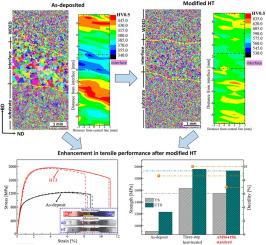复杂几何形状的增材制造超高强度钢结构的裂缝预防和性能改进
IF 4.7
Q2 ENGINEERING, MANUFACTURING
引用次数: 0
摘要
混合线弧定向能沉积(WDED)技术将复杂的特征沉积在锻造底座上,为制造几何形状复杂的超高强度钢部件,特别是航空航天应用,提供了一种经济高效的解决方案。然而,在锻后热处理过程中,基锻/铸模界面的开裂限制了其广泛应用。本研究探讨了界面开裂的根本原因,强调微观结构的不均匀性、元素偏析和相变应力可能是主要的影响因素。一种改进的三步后热处理纳入了正火步骤,以减轻这些问题。优化后的工艺在应用常规淬火步骤之前,通过细化先验奥氏体晶粒成功地抑制了裂纹。这种增强的拉伸性能超出了AMS6419K标准,支持混合WDED在航空航天结构中的工业实施。本文章由计算机程序翻译,如有差异,请以英文原文为准。

Insights into crack prevention and property improvement for additively manufactured ultra-high-strength steel structures with complex geometries
Hybrid wire-arc directed energy deposition (WDED), in which complex features are deposited onto a forged base, offers a cost-effective solution for manufacturing geometrically complex ultra-high-strength steel components, particularly for aerospace applications. However, cracking at the base forging/build interface during post-build heat treatment limits its widespread application. This study investigates the underlying causes of interfacial cracking, highlighting microstructural inhomogeneity, elemental segregation and transformation stresses as likely key contributing factors. A modified three-step post-build heat treatment incorporating a normalisation step was developed to mitigate some of these issues. The optimised process successfully suppressed cracking by refining prior-austenite grains before the application of a conventional quenching step. This enhanced tensile performance beyond AMS6419K standards, supporting the industrial implementation of hybrid WDED in aerospace structures.
求助全文
通过发布文献求助,成功后即可免费获取论文全文。
去求助
来源期刊

Additive manufacturing letters
Materials Science (General), Industrial and Manufacturing Engineering, Mechanics of Materials
CiteScore
3.70
自引率
0.00%
发文量
0
审稿时长
37 days
 求助内容:
求助内容: 应助结果提醒方式:
应助结果提醒方式:


